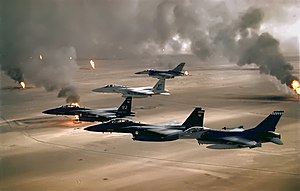Gulf War air campaign
| Gulf War Air Campaign (Operations: Desert Storm, and Desert Shield) | |||||||
|---|---|---|---|---|---|---|---|
| Part of Gulf War | |||||||
 |
|||||||
|
|||||||
| Belligerents | |||||||
|
|
|
||||||
| Commanders and leaders | |||||||
|
|
|
||||||
| Strength | |||||||
| 2,250 combat aircraft | 500 combat aircraft, numerous air defence systems | ||||||
| Casualties and losses | |||||||
| 46 killed or missing 8 captured 75 aircraft ‒ 52 fixed-wing aircraft and 23 helicopters |
10,000–12,000 killed 105 aircraft lost on the ground 36 aircraft shot down in air-air combat |
||||||
| 2,000—3,000 Iraqi civilians killed | |||||||
The air campaign of the Gulf War, also known as the 1991 bombing of Iraq, started with an extensive aerial bombing campaign on 17 January 1991. The coalition flew over 100,000 sorties, dropping 88,500 tons of bombs, widely destroying military and civilian infrastructure. The air campaign was commanded by USAF Lieutenant General Chuck Horner, who briefly served as Commander-in-Chief – Forward of U.S. Central Command while General Schwarzkopf was still in the United States. The British air commanders were Air Vice-Marshal Andrew Wilson (to 17 November) and Air Vice-Marshal Bill Wratten (from 17 November). The air campaign largely finished by 23 February 1991 when the coalition invasion of Kuwait took place.
The initial strikes were composed of Tomahawk cruise missiles launched from warships situated in the Persian Gulf, F-117A Nighthawk stealth bombers with an armament of laser-guided smart bombs, and F-4G Wild Weasel aircraft armed with HARM anti-radar missiles. These first attacks allowed F-14, F-15, F-16, and F/A-18 fighter bombers to gain air superiority over the country and then continue to drop TV and laser-guided bombs.
...
Wikipedia
